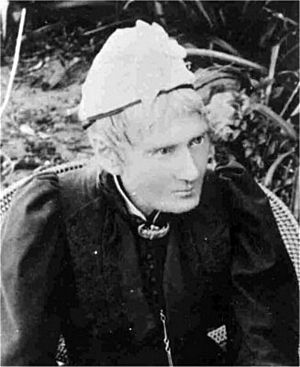Mary Elizabeth Barber facts for kids
Quick facts for kids
Mary Elizabeth Barber
|
|
|---|---|
 |
|
| Born | 5 January 1818 South Newton, Wiltshire, England
|
| Died | 4 September 1899 (aged 81) Pietermaritzburg, South Africa
|
| Nationality | British |
| Spouse(s) | Frederick William Barber |
| Scientific career | |
| Fields | |
Mary Elizabeth Barber (born January 5, 1818 – died September 4, 1899) was a British scientist who lived in the 1800s. Even though she didn't go to a formal school, she became well-known for her work in botany (the study of plants), ornithology (the study of birds), and entomology (the study of insects).
Mary was also a talented poet and painter. She drew pictures for her scientific work. Her discoveries were published by important groups like the Royal Entomological Society in London and the Linnean Society of London.
Contents
Early Life and Learning
Mary Elizabeth Bowker was born in South Newton, Wiltshire, England, on January 5, 1818. She was one of eleven children. In 1820, her family moved to Cape Colony, South Africa. They were part of a group called the 1820 Settlers. These British families were offered land by the South African government.
Mary's father, Miles Bowker, was a sheep farmer. He started a school for his children and workers. He loved nature, and this greatly influenced what his children learned. Mary and her brothers all enjoyed studying nature.
A New Interest in Plants
In 1838, a book called The genera of South African plants changed Mary's life. It was written by an Irish botanist named William Henry Harvey. Mary was very interested in how plants were built and how they were classified using the Linnean system. This system helps scientists organize living things into groups.
The author of the book asked for plant samples. Mary began sending him specimens. At that time, it was unusual for women to be involved in scientific discussions. Mary didn't even tell Harvey she was a woman at first! She had a lot of freedom to do this work. Her father encouraged her, and the culture in South Africa was more open than in England.
Mary became one of Harvey's main suppliers of plants from South Africa. She helped him name and classify many new species. Over almost 30 years, she sent him about 1,000 different plant species with notes. She also wrote to another British botanist, Joseph Dalton Hooker.
In 1842, Mary married Frederick William Barber. He was a chemist and farmer in South Africa. They had two sons and one daughter.
Contributions to Science
Mary Elizabeth Barber made big contributions to science. She collected and studied many plants and animals in South Africa. Because of her important work, several plant species were named after her.
Discovering New Plants
Mary and her younger brother, James Henry Bowker, sent many unknown plant species to important plant collections. These included the herbarium at Trinity College Dublin and the Royal Botanic Gardens in Kew.
One famous plant she discovered is Aloidendron barberae, also known as the tree aloe. She found this plant in South Africa and sent samples to Kew. In 1874, a scientist named William Turner Thiselton-Dyer named it after her. She also discovered Lotononis harveyi, which was named "Mrs. Barber's beauty."
Studying Insects
Mary became interested in entomology (the study of insects). She started studying African moths and butterflies with her brother, James Henry Bowker. In 1863, she contacted an entomologist named Roland Trimen to share her findings.
Her observations helped Charles Darwin in his studies. Darwin was a famous scientist known for his theory of evolution. Mary's work helped him understand how moths help pollinate orchids. Mary exchanged letters and observations with Darwin and other scientists. Her influence on Darwin's work was often shared through Trimen.
Joining Scientific Groups
Mary Barber's scientific work was recognized in 1878. She was invited to become a member of the South African Philosophical Society. This was a very special honor at the time. The Linnean Society in London, for example, did not allow women members until 1905. This shows how advanced the South African society was, and how important Mary's work was.
Mary joined the South African Philosophical Society on June 26, 1878. Later that year, her paper about the unique colors of animals was published. In this paper, she discussed how female animals choose mates based on their looks. She observed that females often pick males with showy displays or shiny feathers.
She also became the first female member of the Ornithologischer Verein in Vienna. This was the main bird-watching society in Austria. Several of her papers were translated into Hungarian.
Other Activities
In the 1850s, Mary helped her older brother, Thomas Holden Bowker. They collected some of the first Stone Age tools found in South Africa.
In the 1870s, Mary wrote articles about the discovery of diamonds and gold in South Africa. She also painted pictures of the diamond fields.
Later Life
In 1889, Mary finally had enough money to visit Europe. She toured the Royal Botanic Gardens at Kew for the first time. She also visited scientific friends across Europe. Mary Elizabeth Barber passed away in Pietermaritzburg, South Africa, in 1899.
Images for kids
See also
 In Spanish: Mary Elizabeth Barber para niños
In Spanish: Mary Elizabeth Barber para niños


